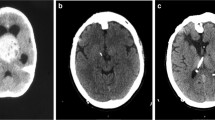Summary
One hundred and sixteen patients wiht high grade glioma were entered into a prospective phase two study and treated with accelerated radiotherapy from 1988 to 1993. In this cohort of patients we analysed speech deficit as a subdivision of global functional status in terms of incidence, category and prognosis for survival.
Forty three patients (37%) had a speech deficit at presentation. Eighty percent of these had a component of expressive dysphasia, associated with considerable degree of awareness and distress. The overall median survival was 9.5 months. On univariate analysis, median survival in patients with speech difficulties (6 months) was worse than patients with normal speech (10.5 months) (log rang p = 0.005). Multivariate analysis established independent significance from age, Karnofsky Performance Status (KPS), gender, histological grade, extent of surgery and seizures.
This paper highlights the importance of assessing individual categories of functional disability which in patients with high grade glioma include mobility, cognitive function and communication. Each of these factors may seriously affect an individual's activities of daily living, hence quality of life and separate analysis has a number of clinical implications. Firstly, with over a third of patients suffering speech difficulties, adequate speech therapy facilities should be freely available to score the degree of deficit, devise co** strategies and institute communication therapy. Secondly, an understanding of prognostic factors aids the critical analysis of phase two studies and the design and stratification of future prospective trials which should include an analysis of speech deficit. Thirdly, separating individual patients into good and bad prognostic groups can assist strategic management decisions.
Similar content being viewed by others
References
MRC Brain Tumour Working Party: Prognostic factors for malignant glioma: Development of a prognostic index. J Neuro-Oncol 9: 47, 1990
EORTC Brain Tumour Group: Evaluation of CCNU, VM-26 plus CCNU and procarbazine in supratentorial brain gliomas. J Neurosurg 55: 27, 1981
Curran WJ, Scott CB, Horton J, Nelson JS, Weinstein A, Fischbach J, Chang CC, Rotman M, Asbell S, Krisch R, Nelson D: Recursive partioning analysis of prognostic factors in three radiation therapy oncology group malignant glioma trials. Journal of the Cancer Institute 85:9: 769–705, 1993
Walker MD, Green SB, Byar DP & 14 others: Randomised comparisons of radiotherapy and nitrosoureas in the treatment of malignant glioma after surgery. N Eng J Med 3032: 1323, 1980
Green SB, Byan DP, Walker MD & 14 others: Comparison of carmustine, procarbazine and high-dose methylprednisolone as additions to surgery and radiotherapy for the treatment of malignant glioma. Cancer treat. Rep 67: 121, 1983
Walker MD, Alexander E, Hunt WE & nine others: Evaluation of BCNU and/or radiotherapy in the treatment of anaplastic astrocytomas. J neurosurg 49: 333, 1978
Bleehen NM, Stenning SP on behalf of the MRC Brain Tumour Working Party: Medical Research Council trial of two radiotherapy doses in the treatment of grades 3 and 4 astrocytoma. Br J Cancer 64: 769–774, 1991
Deutsch M, Green SB, Strike TA: Results of a randomized trial comparing BCNU plus radiotherapy, streptozotocin plus radiotherapy, BCNU plus hyperfractionated radiotherapy and BCNU following misonidazole plus radiotherapy in the postoperative treatment of malignant glioma. Int J Radiat Oncol Biol Phys 16: 1389–96, 1986
Nelson JS, Curran WJ, Scott CB, Horton J: Hyperfractionated radiation therapy and bis-chloroethyl nitrosourea in the treatment of malignant glioma: Possible advantage Observed at 72 Gy in 1.2 Gy BID fractions: Report of the RTOG prot. 8302. Int J Radiat Oncol Biol Phys 25: 193–207, 1993
Karnofsky D, Burchenal J: The clinical evaluation of chemotherapeutic agents in cancer. In: Mcleod CM (ed) Evaluation of chemotherapeutic agents in cancer. New York: Columbia University Press: 1949, 191–205
Clark A, Fallowfield L: Quality of life measurements in patients with Malignant disease: A review. J.R. Soc Med 79: 165–169, 1986
Brada M, Thomas G, Elyan S, Hines F, Ashley S, Stenning S: Improving acceptability of high dose radiotherapy by reducing the duration of treatment: Accelerated radiotherapy in high grade glioma. Journal of Neuro-Oncology Vol 21, No. 1, p. 20, 1994
Kernohan J, Sayre G: Tumours of the central nervous system-Astrocytomas. In: Firminger HT (ed) Atlas of Tumour Pathology, Section 10. Fascicle 35. Washington DC: Armed Forces Institute of Pathology, pp 313–332, 1952
Peto R, Pike MC, Armitage P, Breslow NEet al.: Design and analysis of randomised clinical trials requiring prolonged observation of each patient. Part 2. Analysi and examples. Br J Cancer Vol 35, No. 1, p 1–39, 1977
Cox DR: Multivariate analysis of survival data: Regression models and life tables. J.R. Stat Soc B34, P187–220, 1972
Granger CV, Dewis LS, Peters NC, Sherwood CC, Barrett J: Stroke rehabilitation: analysis of repeated Bartel index measures. Arch Phys Med Rehabil 60: 14–17, 1979
Gresham G, Philips T, Labi M: ADL status in stroke, relative merits of three standard indexes. Arch Phy Med Rehabil 61: 355–58, 1980
Haas J, Vogt G, Shiemann M, Patzold U: Aphasia and nonverbal inelligence in brain tumour patients. J Neurol 227: 209–218, 1982
Kanzer M: Early symptoms of aphasia with brain tumours. J Nerv Ment Dis 95: 702–720, 1942
Miceli G, Caltagirone C, Gainotti G: Influence of age, sex, litaracy and pathological lesion on incidence, severity and type of aphasia. Acta Neurol Scand 64: 370–382, 1981
Recht LD, Mckathy K, O'Donnell BF: Tumour-associated aphasia in left hemisphere brain tumours: The importance of age and tumour grade. Neurology 38: 48–50, 1989
Goodglass H, Kaplan E: Boston diagnostic examination booklet. Lea and Febiger 1983
Mahoney F, Barthel D: Functional evaluation: the Barthel index. Marylands State Med J 14: 61–65, 1965
Chang CH, Horton J, Schonfield D & 6 others: Comparison of postoperative radiotherapy and combined postoperative radiotherapy and chemotherapy in the multidisciplinary management of malignant gliomas. Cancer 52: 997, 1983
Author information
Authors and Affiliations
Rights and permissions
About this article
Cite this article
Thomas, R., O'Connor, A.M. & Ashley, S. Speech and language disorders in patients with high grade glioma and its influence on prognosis. J Neuro-Oncol 23, 265–270 (1995). https://doi.org/10.1007/BF01059960
Issue Date:
DOI: https://doi.org/10.1007/BF01059960



